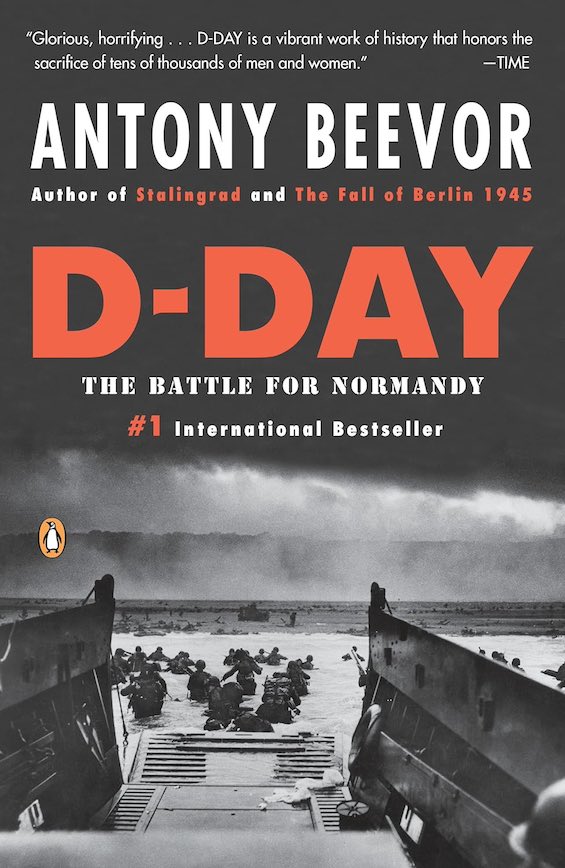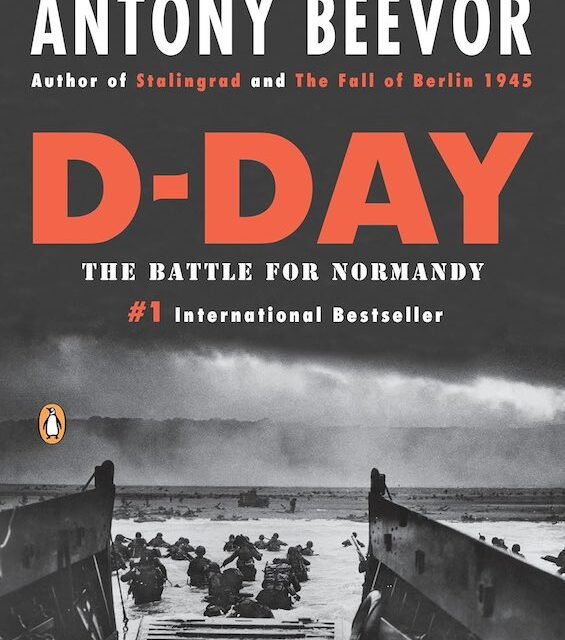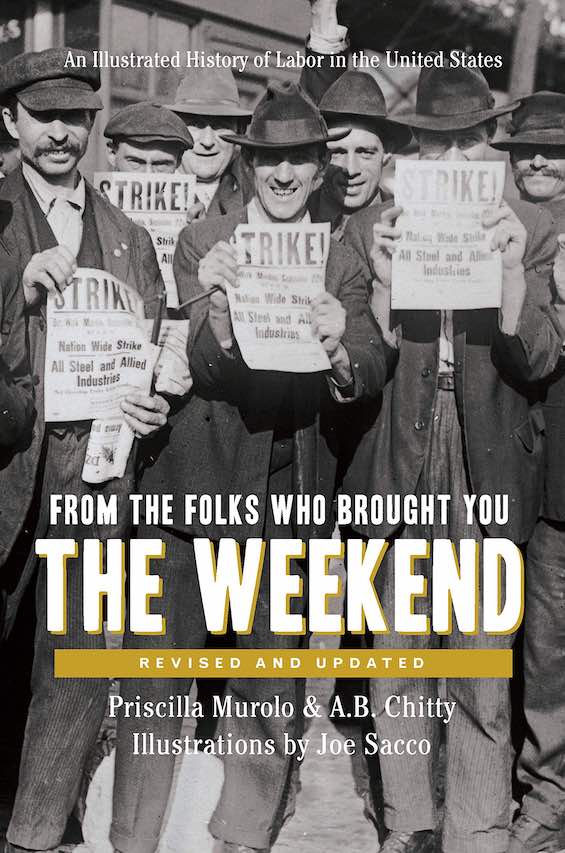
Estimated reading time: 7 minutes
For a majority of Americans, the events of June 6, 1944 represent the most important battle of World War II. Of course, the landings on D-Day and the campaign for Normandy that followed during the months of June, July, and August involved far, far more troops than the 156,000 who entered France on that first day. Some two million were on the ground by the time of the liberation of Paris late in August. Even so, its strategic importance aside, D-Day was a modest operation compared to the titanic battles the Eastern Front. There, millions of Russians faced off with massive Axis armies, and millions perished. But we Americans have always thought ourselves a people apart. And there is no doubt that D-Day and Normandy offer abundant examples of human drama—enough to fill innumerable books, films, and television screens. Antony Beevor’s history, D-Day: The Battle for Normandy, is ample proof of that.
A story that’s hard to follow
Scattered throughout Beevor’s account are poignant anecdotes drawn from the diaries and letters of soldiers on the ground in France. Unfortunately, these dramatic scenes are scattered about within a confusing village-by-village recitation of troop movements. We visit every key meeting-place between Allied and Axis soldiers, sometimes repeatedly, as villages and towns shift sides in the tide of battle. Saint-Lô. Avranches. Carentan. Bayeux. Cherbourg. They’re all here. So is every river and stream. But Beevor rapidly shifts scenes from page to page, and often paragraph to paragraph, from German to English to American to Canadian units and later to the French. Then, unaccountably, he lurches into the tents and headquarters buildings of the generals, zeroing in on their own internal conflicts over policy and politics. Without a minutely detailed knowledge of that time and place, any reader will find the story exceedingly hard to follow.
D-Day: The Battle for Normandy by Antony Beevor (2009) 624 pages ★★★☆☆

One area of strength in Beevor’s account
Amid the welter of detail, so much of it unnecessary and distracting, Beevor succeeds admirably in laying out one vital element of the story of D-Day and Normandy. He relates what went wrong. And in fact a great deal of the time the generals’ plans met harsh reality on the ground. On the Allied side alone, the facts are disturbing. Paratroopers dropped miles from their designated landing zones. Thousands of soldiers relegated to the sidelines with “combat fatigue.” Friendly fire among Allied troops. Heavy bombers and artillery dropping tons of explosives on the men they were supposed to protect. Field Marshal Montgomery acting consistently so arrogant and narcissistic that he succeeded in turning most of the senior American generals anti-British. French troops disobeying the orders of their American superior officers. And Allied action, especially the bombing, that killed 20,000 French civilians and destroyed many historic villages and towns, sometimes unnecessarily.
Of course, even more went wrong on the German side. The massacres of French maquis and civilians alike by the hundreds. Large units of Russian, Polish, and Volksdeutche troops deserting en masse to the Allies. Squabbling among German officers, especially as it became increasingly clear that they’d lost the battle. (They already knew they’d lost the war.) And, above all, the clueless and absurdly wrong-headed orders from Adolf Hitler and the Oberkommando der Wehrmacht that assured the Nazi defeat. Normandy was a battle Germany might otherwise have won.
An account for serious students of military history, not the general reader
Throughout D-Day, Beevor switches, often from one paragraph to the next, from one company or battalion to another. He also switches from one town or village to another without preamble. And he invariably mentions the full name of every unit’s commander. In relating the numbers of casualties, he cites precise figures instead of rounding them out to make them more accessible. All this minute detail represents a constant hurdle for the reader. And the habitual drift across the terrain of northern France is likely to be a particular problem. To follow Beevor’s account closely, you’d need an extremely detailed map of the region. Otherwise, you’re not likely to know which way is up. In other words, I do not recommend this book for the general reader.
Beevor’s D-Day is, instead, an account intended for the historical record. The book will serve serious students of military history as well as military officers as a source of the detailed information they might need to understand the tactical realities of the Normandy campaign. Its best use will probably be as a reference book, a repository of detailed information about the events of D-Day and Normandy that any researcher might care to explore.
Dissecting the Nazi military machine
One of the more confusing aspects of Beevor’s book for the general reader is his casual use of Nazi military jargon. For starters, he never makes clear how the German military is organized. That leads to another layer of puzzlement. Here, then, is the Big-Picture view of the Nazi military machine:
- Most German soldiers belonged to the army, the Wehrmacht, which operated under the orders of the Oberkommando des Wehrmacht (OKW). General Feldmarschall Wilhelm Keitel headed the OKW from 1938 to 1945. But Adolf Hitler called the shots throughout.
- Some 800,000 to 900,000 additional troops formed the Waffen-SS, the military arm of the much larger Schutzstaffel (SS), which was primarily involved in the perverted Nazi version of law enforcement. As Beevor emphasizes, these troops tended to be fanatically loyal Nazis and were generally far more effective as soldiers than the men of the Wehrmacht. The SS as a whole was under the command of Reichsführer Heinrich Himmler.
- The fastest-moving and most effective units of the Nazi ground forces were the Panzer divisions, the armored (i.e., tank) divisions of both the Wehrmacht and the Waffen-SS. At full strength, each Panzer division included some 500 tanks.
- The Luftwaffe, or air force, was largely a spent force by the summer of 1944, overwhelmed by the British and Americans. But German planes did enter the fray from time to time. Former World War I fighter ace Reichsmarchall Hermann Göring famously ran the Luftwaffe.
- Of course, the Nazis also had naval forces. The Kriegsmarine under Großadmiral Karl Dönitz included the U-boat forces he had commanded before he replaced Großadmiral Erich Raeder as head of the navy. But the navy played no discernible role of any importance at D-Day and Normandy.
About the author

British military historian Sir Antony Beevor was born in London in 1946, having missed by a single year any personal connection World War II. He has written thirteen works of military history, mainly on the Second World War. Beevor was educated at the Royal Military Academy Sandhurst and commanded a troop of tanks in Germany before leaving the army in 1970 to write full-time. He has won numerous awards for his work and bills himself as Britain’s #1 bestselling military historian, having sold more than 8.5 million copies of his work. He is married and has two children.
For related reading
Other books on D-Day that I’ve read include Normandy ’44: D-Day and the Epic 77-Day Battle for France by James Holland (Debunking the myths about D Day and Normandy) and Brothers, Rivals, Victors: Eisenhower, Bradley, Patton and the Partnership That Drove the Allied Conquest in Europe by Jonathan W. Jordan (The American generals who led the Allies to victory). Both books are far more readable than this one.
You might also enjoy:
- 10 top nonfiction books about World War II
- Books about World War II in the Pacific
- Good books about the Holocaust
- 7 common misconceptions about World War II
- The 10 most consequential events of World War II
And you can always find my most popular reviews, and the most recent ones, on the Home Page.


























